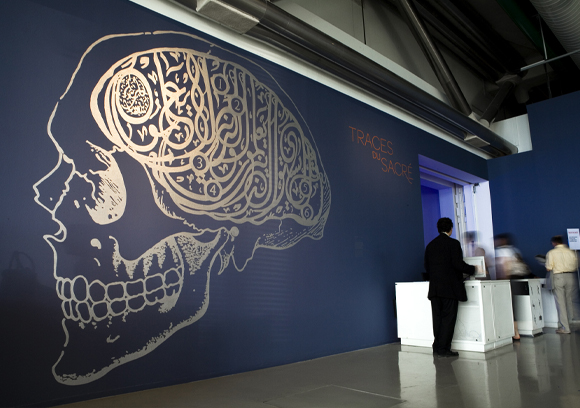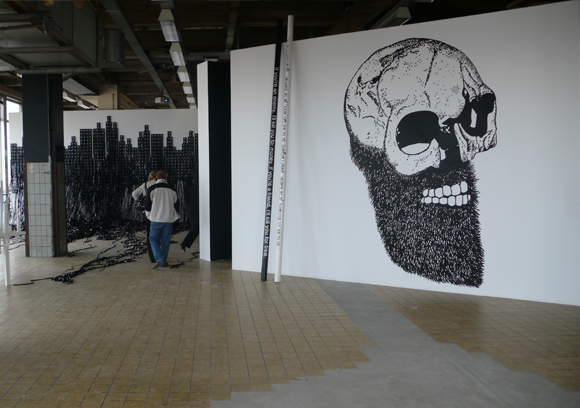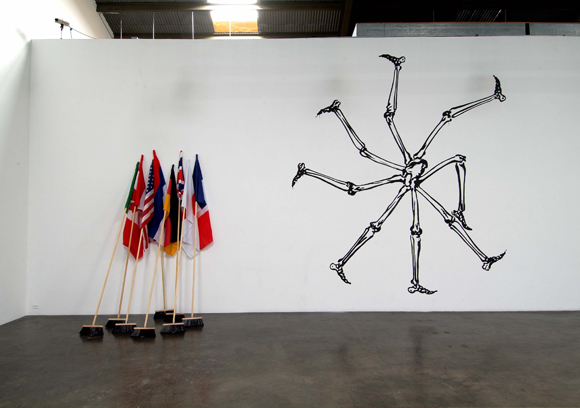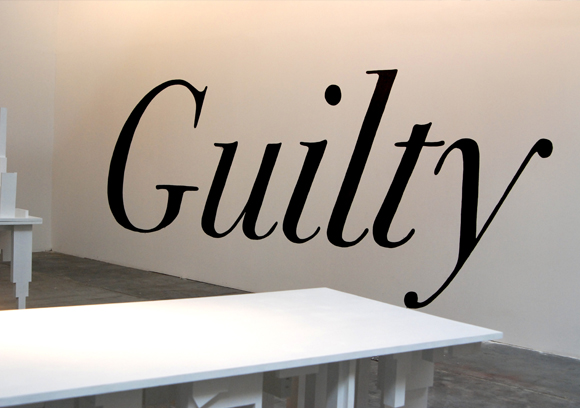| |
|
07.
 | Technologia
| Technologia |
| |

'' The works gathered under the title « Technologia » constitute an interrogation about one particular type of production in today’s world: the production of meaning and significations. ''
Studio Fatmi, January 2018

Hard Head
Exhibition view from 180° Behind Me, Göteborgs Konsthall, 2018, Göteborg.
Courtesy of the artist and Ceysson & Bénétière, Paris.

Hard Head
Exhibition view from Traces du sacré, Centre Georges Pompidou, 2008, Paris.
Courtesy of the artist and Ceysson & Bénétière, Paris.

Dead or Alive
Exhibition view from Fuck architects : Chapter II, CAC Le Creux de l'Enfer, 2008, Thiers.
Courtesy of the artist.

The Great Forgiveness
Exhibition view from 1ere Biennale de Bruxelles, 2008, Brussels.
Courtesy of the artist.

The Cercle
Exhibition view from Something is possible, Shoshana Wayne Gallery, 2007, Los Angeles, 2007.
Courtesy of the artist.

Guilty
Exhibition view from Art, ecology and the politics of change, 8ème biennale de Sharjah, 2007, Dubaï.
Courtesy of the artist and Lawrie Shabibi, Dubai.
|
|
2011, black acrylic painting, in situ.
Exhibition View from Drawings, Paradise Row Gallery, 2011, London.
Courtesy of the artist and Lawrie Shabibi, Dubai.
|
|
|
|
|
« Technologia » est une peinture murale dont le titre sert à désigner plusieurs projets artistiques réalisés entre 2010 et 2011 : projections lumineuses au sol, mapping cinétique sur les édifices de plusieurs grandes villes à travers le monde, vidéos accompagnées d'un enregistrement sonore, ou encore caissons lumineux aux allures d'objets de design. La peinture murale est une œuvre circulaire en noir et blanc, composée d'une série de cercles inscrits et tangents au cercle qui forme le contour de l'œuvre, à l'exception d'un cercle blanc de petit diamètre qui occupe le centre de la composition. Les surfaces des disques sont alternativement noires et blanches. Un des cercles est orné de motifs calligraphiques et religieux en arabe classique, tandis que le disque extérieur présente sur sa surface une série de traits qui semblent converger vers l'intérieur.
Les œuvres regroupées sous le titre « Technologia » s'interrogent au sujet d'un type de production particulier du monde contemporain : celle du sens et des significations. Comment naissent ces dernières? De quelle manière interagissent les différents systèmes de significations qui composent notre réalité, tels que l'art et la religion? Quel rapport l'individu entretient-il à ces systèmes de significations? Pour répondre à ces questions, mounir fatmi réinterpréte le rotorelief duchampien. Les rotoreliefs sont des machines à produire des illusions d'optique. Leur dispositif visuel et cinétique allie les techniques du monde moderne industrialisé et celles de l'art optique. Les rotoreliefs de mounir fatmi organisent quant à eux la rencontre de l'art contemporain et de la calligraphie religieuse, à partir de techniques inspirées des machines et de notions linguistiques développées par Wittgenstein sur la naissance des significations en fonction des usages et des contextes.
L'illusion d'optique est ici obtenue avec la perte ou la multiplication du centre de la composition. Son effet impressif suggère l'idée d'une production frénétique d'images qui viennent s'imprimer avec violence sur la rétine du spectateur. L'œuvre exerce également une séduction visuelle et son esthétique et sa géométrie ne laisse pas d'attirer l'œil. Une séduction qui s'exerce peut-être également en raison d'un aspect mimétique et oculaire du rotorelief. L'œuvre a un effet spéculaire sur le spectateur qui pourrait y reconnaître comme le reflet de son propre regard, sous l'aspect d'un œil assailli par les images et les stimuli innombrables de son environnement. A moins qu'il ne s'agisse de l'œil monumental d'un hypothétique Big brother à qui rien n'échappe, et qui tente d'imposer à tous sa vision du monde ? Les rotoreliefs de mounir fatmi sont à envisager comme des machines où s'observent les interactions, les chocs ou les fusions entre les grands systèmes de significations de notre époque : religion, art, consommation, médiatisation… Le cercle y tient la place d'une figure privilégiée permettant de rendre compte d'un fonctionnement de systèmes complexes et de la relation de l'individu à ceux-ci et à la réalité à laquelle ils donnent forme.
Les peintures de la série « Technologia » communiquent au spectateur le vertige du monde, de ses chocs et de ses productions incessantes, et dans une acception proche de son étymologie, l'œuvre teste les compétences du spectateur à percevoir, associer ou interpréter les signes au sein d'un monde en perpétuel renouvellement.
Studio Fatmi, Janvier 2018.
|
|
« Technologia » is a wall painting whose title designates several artistic projects created between 2010 and 2011: luminous projections on the ground, kinetic mappings on buildings in several big cities around the world, videos accompanied by sound recordings and light boxes that look like designer objects. The wall painting is a circular work in black & white, composed of a series of circles inscribed in and tangent to the circle that forms its outline, with the exception of one small white circle in the center of the composition. The surfaces of the disks are alternately white or black. One of them is adorned with calligraphic and religious motifs in classic Arabic, whereas the external disk’s surface presents a series of lines that seem to converge towards the inside.
The works gathered under the title « Technologia » constitute an interrogation about one particular type of production in today’s world: the production of meaning and significations. How do they come to be? In what way do the various signification-producing systems that make up our reality interact, such as art and religion? What relation do individuals entertain with these systems of significations? To answer these questions, mounir fatmi reinterprets Marcel Duchamp’s rotorelief. Rotoreliefs are machines that produce optical illusions. As a visual and kinetic device, they combine the techniques of the modern industrialized world with those of optical art. As for mounir fatmi’s rotoreliefs, they allow the encounter of contemporary art with religious calligraphy, using techniques inspired by machines as well as linguistic notions developed by Wittgenstein regarding the creation of significations according to usage and context.?
The optical illusion is obtained here through the loss or the multiplication of the center of the composition. Its impressive effect suggests the idea of a frenetic production of images that violently impress themselves on the viewer’s retina. The work also exercises a visual seduction and its esthetic and geometry constantly appeal to the eye. This seduction perhaps also exercises itself because of the mimetic and visual aspect of the rotorelief. The piece has a spectacular effect on viewers, who could even perceive in it the reflection of their own gaze, with an aspect akin to an eye bombarded with images and the endless stimuli emanating from its environment. Unless this is the monumental eye of some all-seeing Big Brother that tries to impose its vision of the world on everyone? Mounir Fatmi’s rotoreliefs are to be seen as machines where interactions, collisions and fusions between the great signification-producing systems of our times can be observed: religion, art, consumption, media exposure… The circle is favored here, as it enables the transcription of the functioning of complex systems and the way individuals relate to them and the reality they fashion.
The paintings of the series « Technologia » convey to the viewer the vertigo of the world, of its collisions and endless productions, and in an acceptation that is close to the word’s etymology, the work challenges the viewer’s capacity to perceive, associate and interpret signs in a world in constant renewal
Studio Fatmi, January 2018.
|
|
|
|